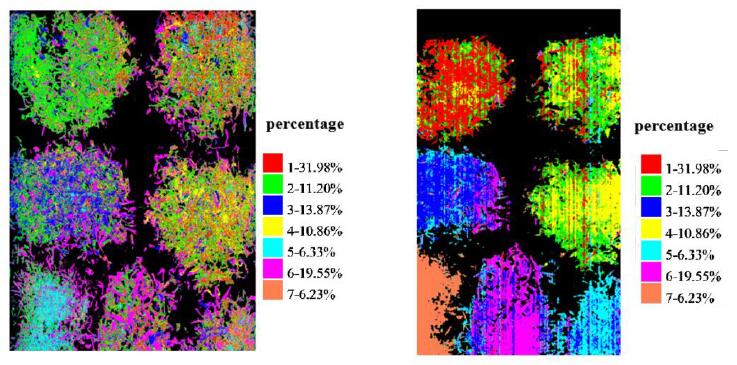Classification of tobacco stalk filaments based on imaging hyperspectral techniques
Introduction
Tobacco is an important cash crop in China and the world. With the improvement in life quality, people pay more and more attention to the quality and taste of tobacco products. The application of near-infrared spectroscopy as a rapid nondestructive testing technique in the tobacco field is also increasing. As early as 1977, McClure et al[1] used spectral second-order derivative regression analysis to establish a model for the detection of reducing sugar content in tobacco leaves by NIR method, with a model correlation coefficient of 0.968 and a prediction standard deviation of 1.36. Hanam et al[2] used various artificial neural network algorithms to predict the nicotine content of tobacco leaves. After decades of development, NIR technology is now widely used in the tobacco industry. Although NIR spectroscopy for non-destructive rapid detection in tobacco industry can be applied to process analysis, however, non-imaging NIR spectroscopy is not suitable for quantitative analysis and dispersive sample analysis, because the interference with external factors cannot be effectively eliminated, its model needs constant maintenance correction after establishment and the test sensitivity is relatively low and the relative error are relatively large .Qing Gu et al[3] used hyperspectral imaging technique for The early non-destructive detection of tomato spotted wilt virus (TSWV) infection in tobacco by using hyperspectral imaging; Marcelo C. A. Marceloa et al[4] used a near-infrared hyperspectral system to make accurate classification assessment of different tobacco stalk positions, leaf color and leaf quality; Keqiang Yu et al[5] used a visible/near-infrared hyperspectral imaging system to detect heavy metal Hg-stressed tobacco crops; Ting Guo et al[6] used hyperspectral imaging to study the quantitative relationship between chlorophyll content and three canopy hyperspectral parameters in tobacco; Hong-yan Zhu et al[7] used hyperspectral imaging to classify and identify tobacco from different diseases; Frederico L.F. Soares et al[8] have applied hyperspectral imaging system to high-speed sorting in the tobacco industry.
At present, most of the tobacco stalk content detection is done by sampling at the production line, then crushing, separating the stalks, and then weighing to derive the tobacco stalk content, which not only has a long cycle time and complicated operation, but also affects the normal production and cannot be removed from the production line of a timely manner for the tobacco that exceeds the standard. The purpose of this study is to analyze and study different varieties of tobacco shreds and stalk shreds by using imaging hyperspectral technology nondestructive monitoring technology, in order to identify different varieties of tobacco shreds and stalk shreds quickly by imaging hyperspectral technology.
1 Materials and Methods
1.1 Materials
The tobacco yarn and stem yarn for this study were provided by Yunnan Hongta Group, and there were seven samples, Including tobacco, blended tobacco, stemmed tobacco, expanded tobacco, flake tobacco, stemmed tobacco at different process temperatures 158 and stemmed tobacco 160, and each part was taken on a black cloth for imaging hyperspectral equipment to obtain image information.
1.2 Hyperspectral image acquisition
The GaiaSorter hyperspectral sorter system (V10E, N25E-HS) of Jiangsu Shuangli Hepu Technology Co., Ltd. was used for hyperspectral image data acquisition. The system is mainly composed of hyperspectral imager, surface array camera, halogen lamp light source, dark box and computer, as shown in Fig. 1. The experimental instrument parameters are set as in Table 1.

Figure 1 GaiaSorter hyperspectral instrument
Table 1 GaiaSorter hyperspectral instrument system parameters
|
Serial number
|
parameters
|
V10E
|
N25E-HS
|
|
1
|
Spectral range
|
400-1000 nm
|
1000-2500 nm
|
|
2
|
Spectral resolution
|
2.8 nm
|
10 nm
|
|
3
|
Spectral sampling rate
|
0.7nm
|
7.6×14.2
|
|
4
|
Slit size
|
30μm*9.6mm
|
30μm*9.2mm
|
|
5
|
Numerical aperture
|
F/2.4
|
F/2.0
|
|
6
|
Number of bands
|
520
|
288
|
When performing hyperspectral image acquisition, the camera exposure time, stage movement speed, and distance between objectives need to be set. These 3 parameters affect each other, and the purpose of image adjustment is to make the acquired images suitable for size, clearly and without distortion. After repeated attempts, the objective height was set to 31 cm, the exposure time was set to 10 ms, and the stage movement speed was set to 6.0 mm/s (400-1000 nm) and 16 mm/s (1000-2500 nm).The image acquisition software was completed by the hyperspectral imaging system acquisition software provided by Jiangsu Shuangli Hepu Technology Co. The image processing was carried out using ENVI5.3 software. Before the image processing, the acquired spectral images were subjected to image correction, and the image correction equation was as follows:
 (1)
(1)
In equation (1), Rref is the corrected image, DNraw is the original image, DNwhite is the whiteboard corrected image, and DNdark is the blackboard corrected image.
1.3 Spectral noise removal
SG smoothing algorithm can effectively reduce the random noise in the spectral data, and the noise elimination effect is influenced by the number of smoothing points, so SG quadratic polynomial 5-point smoothing is chosen to process the spectral data in this paper.
1.4 Sample selection of interest
The spectra of different samples were selected separately from the acquired hyperspectral images to establish a spectral database for rapid identification of different varieties of tobacco and stems using hyperspectral techniques.
2. Results and analysis
2.1 spectral analysis of samples
Figure 2 shows the false color images taken by mobile phone (left), visible near-infrared camera (750nm/650nm/550nm, middle) and short wavelength infrared camera (2175nm / 1811nm / 1347nm, right). It can be seen from the figure that it is difficult for human eyes ( i.e. mobile phone shooting) to distinguish different varieties of tobacco and stemmed tobacco; It is difficult to distinguish tobacco and stemmed tobacco from the false color image by visible near infrared camera; The false color image of short wavelength infrared camera can distinguish some tobacco and stemmed tobacco, but it is difficult to distinguish different varieties of tobacco and stemmed tobacco.
In order to further analyze the spectral and image differences between tobacco and stemmed tobacco, we selected the spectral reflectance of the seven samples in the image and established the spectral database, so as to further distinguish tobacco and stemmed tobacco through hyperspectral analysis technology. Fig. 3 shows the spectral of tobacco and stemmed tobacco of different varieties. It can be seen from the figure that the overall change trend of spectral reflectance of stemmed tobacco and tobacco is consistent; In the short bands, the spectral reflectance of stemmed tobacco is higher than that of tobacco.

Fig. 2 false color images taken by mobile phone (left), visible near infrared camera (medium) and short wavelength infrared camera (right)

Fig. 3 spectral reflectance curves of different samples in visible near infrared and short wavelength infrared
According to the spectral reflectance of different samples, the spectral database of tobacco and stemmed tobacco was constructed, and then the fast classification and recognition of images was achieved according to the hyperspectral analysis algorithm and chemometrics. The classification effect is shown in Figure 4. It can be seen from the figure that the visible near-infrared camera can only roughly distinguish tobacco sheet, but not the other six samples. The short wavelength infrared camera effectively distinguishes tobacco, stemmed tobacco, flake tobacco, stemmed silk 158 and stemmed silk 160, and roughly distinguished the expanded silk. This is because No. 2 blended silk has established a spectral database as an independent sample, and No. 2 sample contains many kinds of tobacco including expanded silk, which participates in the classification as blended tobacco.
2.2 image classification and analysis of hyperspectral technology

Fig. 4 classification results (left: RGB; middle: visible near infrared classification results; right: short-wavelength infrared classification results)
2.3 percentage analysis of classification results
The most significant advantage of imaging hyperspectral technology is "Combination of image and spectrum", that is, there are both spectral data of near-infrared cameras and image data of ordinary cameras, and each band corresponds to a gray image data. Each gray image includes hundreds of thousands to millions of pixel information, and each pixel information has a continuous spectral, Therefore, after the classification map of tobacco and stemmed tobacco is obtained by using hyperspectral analysis technology and chemometric analysis, the proportion of tobacco and stemmed tobacco of different varieties in the image can be further counted on the basis of the classification map, as shown in Figure 5, which is conducive to the rapid analysis of the proportion of tobacco and stemmed tobacco contained in tobacco, It is no longer necessary to judge the proportion of tobacco and stemmed tobacco according to traditional chemical methods or manual methods.

Figure 5 proportion of tobacco and tobacco stemmed silk of different varieties
2.4 composition analysis of tobacco and stemmed
We all know that smoking is harmful to health. The cigarettes commonly used in our life are mainly blended according to different proportions of tobacco and stemmed tobacco. Cigarettes contain many harmful ingredients, such as nicotine, tar, nitrosamine, carbon monoxide, radioactive substances and other harmful and carcinogenic substances. There are some illegal businesses in the market. They add excessive harmful ingredients to cigarettes, and these harmful substances far exceed the standards given by the National Tobacco administration. Therefore, before packaging the finished products of cigarettes, it is necessary for us to analyze the components of tobacco and stemmed tobacco of cigarettes through hyperspectral nondestructive detection technology, such as the detection of nicotine, tar and nitrosamine, or the detection of chemical components such as total sugar, reducing sugar, total nitrogen, nicotine, protein and Schmidt value. The principle of this kind of detection technology is similar to the application of hyperspectral technology in agriculture.
3 Conclusion
In this study, two types of hyperspectral cameras, visible NIR and short-wave NIR, were used to classify different varieties of tobacco and stem filaments. It is clear from the analysis of the study that the visible NIR camera is not ideal in the classification study of tobacco and stem filaments, and can only distinguish flake filaments, but the short-wave NIR camera is more ideal in the classification study of tobacco and tobacco filaments,it can also effectively resolve tobacco, stem tobacco, flake tobacco Stemmed tobacco 158, Stemmed tobacco 160, and roughly distinguished expanded tobacco. The results of the study lay the foundation for further application of imaging hyperspectral technology in the tobacco industry.
References
[1] MCCLURE W F, NORRIS K H, WEEKS W W. Rapid spectrophotometric analysis of the chemical composition of tobacco[J]. Beiträge Zur Tabakforschung, 2019,11(4): 219-227.
[2] HANA M, MCCLURE W, WHITAKER T, et al. Applying artificial neural networks. I. Estimating nicotine in tobacco from near infrared data[J]. Journal of Near Infrared Spectroscopy, 1995,3(1): 133-142.
[3] GUA Q, SHENG L, ZHANG T, et al. Early detection of tomato spotted wilt virus infection in tobacco using the hyperspectral imaging technique and machine learning algorithms - ScienceDirect[J]. Computers and Electronics in Agriculture, 2019,167.
[4] MARCELO M, SOARES F, ARDILA J A, et al. Fast Inline Tobacco Classification by Near-Infrared Hyperspectral Imaging and Supporting Vector Machines-Discriminant Analysis[J]. Analytical Methods, 2019.
[5] YU K, FANG S, ZHAO Y. Heavy metal Hg stress detection in tobacco plant using hyperspectral sensing and data-driven machine learning methods[J]. Spectrochimica Acta Part A Molecular and Biomolecular Spectroscopy, 2020,245: 118917.
[6] GUO T, TAN C, LI Q, et al. Estimating leaf chlorophyll content in tobacco based on various canopy hyperspectral parameters[J]. Journal of ambient intelligence and humanized computing, 2019,10(8): 3239-3247.
[7] ZHU H, CHU B, ZHANG C, et al. Hyperspectral Imaging for Presymptomatic Detection of Tobacco Disease with Successive Projections Algorithm and Machine-learning Classifiers[J]. Scientific Reports, 2017,7(1): 4125.
[8] SOARES F L F, MARCELO M C A, PORTE L M F, et al. Inline simultaneous quantitation of tobacco chemical composition by infrared hyperspectral image associated with chemometrics[J]. Microchemical Journal, 2019,151: 104225.
 13910278534
13910278534
 010-56370168
010-56370168
 (1)
(1)


